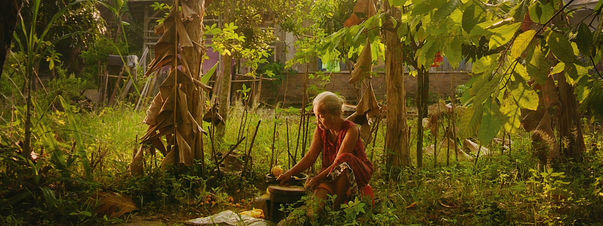How to look from a position of silence - The Look of Silence by Joshua Oppenheimer
By Eduardo Marun

“It is not poetry that is impossible after Auschwitz, but rather prose” Slavoj Zizek
It is usually believed that there is no way to create a story that can give, at least, a certain idea of the horror. This affirmation leaves us with the sole possibility, a certainly comfortable one, of not understanding – or even trying to understand - what we were told was incomprehensible. But perhaps the story does not only belong to the good guys. In this way, Joshua Oppenheimer seems to reject Zizek’s maxim and knows that to try to build his own representation of the genocide of communists in Indonesia in the 70s will probably lead to a an alley of anger, great sadness and shock. In The Look of Silence, Adi, a young ophthalmologist, will search for the story in the citizens who participated actively in the massacre that then turned them into “distinguished” residents, or even heroes. The genocide is over, but the message is still there, embedded in the now weak memory and trembling jaw of the old murderers. As he measures the deterioration of their vision, with an amazing and disturbing temperance, Adi questions the murderers. It is not to demonstrate their accountability, which nobody pretends to hide, but to, in that return to the story of how the murders where carried out, try to find a trace of humanity through, basically, the same question: “do you regret doing it?”. A situation that will repeat itself throughout the film, where us, spectators, will try to find an answer in those eyes, which more than once will insinuate a tear that will never appear. Nicolas Klotz, in his excellent film La question humaine (2007), had already managed to represent, in a present context, a simple human resources employee who during the process of selecting workers is able to dissociate his job from any moral reflection. With this film, Oppenhaimer manages to show that even though many years have passed since the perpetration of the genocide, every time an interviewee is given the chance to regret his actions, what he does is confirm his ordinariness, through meager smiles and pathetic remarks that reach unimaginable points such as drinking the blood of victims so as to maintain a healthy psyche. Passive and bold at the same time, the Texan director, in one of the first shots of the film, decides to introduce us to Adi for the first time observing, sitting and leaning forward, his elbows resting on both knees and holding a pear with his hands, like an attentive and patient spectator, listening to the atrocious feats of some of the murderers. In this way, with his silent eyes, something engaging and compromising is created: we are both spectators of an evil that appears to have no boundaries. What we spectators can barely observe, they are able to say. But he who writes The Look of Silence is far from surrendering to the generators of horror, of willingly handing over the prose. As the shots advance, the film stealthy and gradually turns into a battle to win the story. The same way one of the murderers was capable of conceiving a book where he explains in detail and with images each of the tortures carried out, Oppenheimer waits behind the camera for the battle to take place in those short but long silences, in those faces that repress humanity but express lack of peace. Something he could have achieved – inaccurately perhaps – through, for example, parallel editing, inserts from old footage or intertitles. Adi does not even react when he is questioned directly by one of the interviewees, as if he were giving a silent declaration. In this way, in one of the key sequences of the film, the story imposed by a teacher to his students on the wicked essence of communists, shows the tireless need to fight for the story though, paradoxically, from a place of reservation. Oppenheimer may allow others to talk but he won’t hand over the silence. In The Look of Silence, there is a proximity with the murderers that is not the utopic intention to understand the other, but rather a proximity with a distance. Adi answers patiently to the detailed explanation of the torture and death of his brother given by his murderers, and is even capable of kissing a murderer’s forehead, only because his daughter asks him to forgive him. Beyond the superficial stance of forgiveness, Oppenheimer’s latest film achieves a non imposition of the story through gazes, silences, pauses, victims and murderers, so that spectators are free to build their own account, drawn from the silence and the horror.
Mariángela Martínez Restrepo Talent Press BsAs Coordinator Clara Picasso Text Translator

